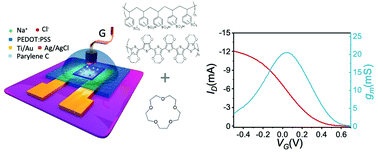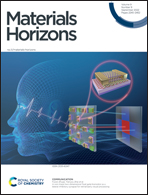Crown ether enabled enhancement of ionic–electronic properties of PEDOT:PSS†
Abstract
Poly(3,4-ethylenedioxythiophene):polystyrene sulfonate (PEDOT:PSS) based organic electrochemical transistors (OECTs) have proven to be one of the most versatile platforms for various applications including bioelectronics, neuromorphic computing and soft robotics. The use of PEDOT:PSS for OECTs originates from its ample mixed ionic–electronic conductivity, which in turn depends on the microscale phase separation and morphology of the polymer. Thus, modulation of the microstructure of PEDOT:PSS film enables us to tune the operation and device characteristics of the resulting OECT. Herein we report enhanced transconductance (20 mS), fast switching (32 μs) and stable operation (10 000 cycles) of modified PEDOT:PSS based OECTs using 15-crown-5 as an additive. Four probe measurements reveal an increased electronic conductivity of the modified PEDOT:PSS film (∼450 S cm−1) while tapping mode atomic force microscopy shows an increased phase separation. Further detailed characterization using spectroelectrochemistry, X-ray photoelectron spectroscopy (XPS) and grazing incidence wide-angle X-ray diffraction (GIWAXS) provides insight into the microstructural changes brought about by the crown ether additive that result in the desirable characteristics of the modified PEDOT:PSS film.



 Please wait while we load your content...
Please wait while we load your content...